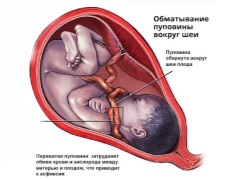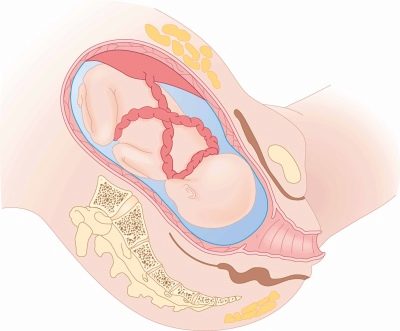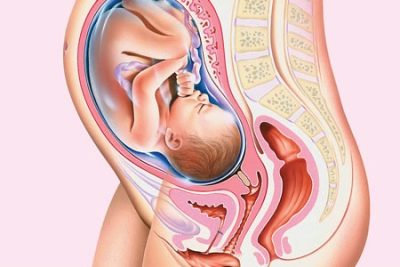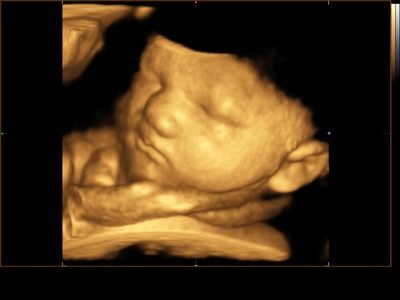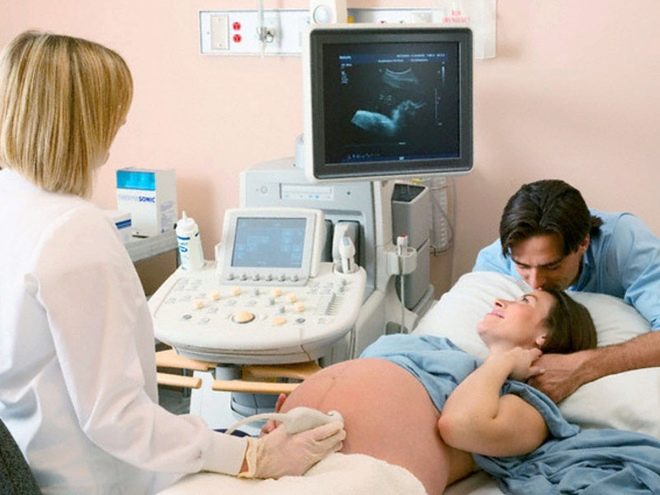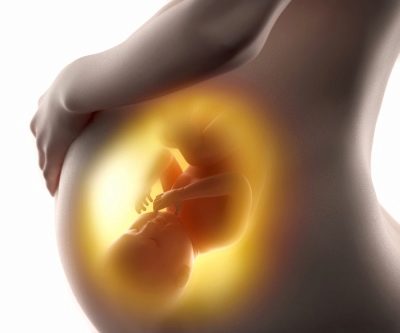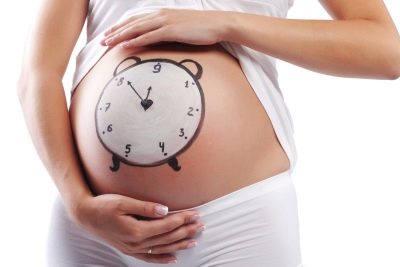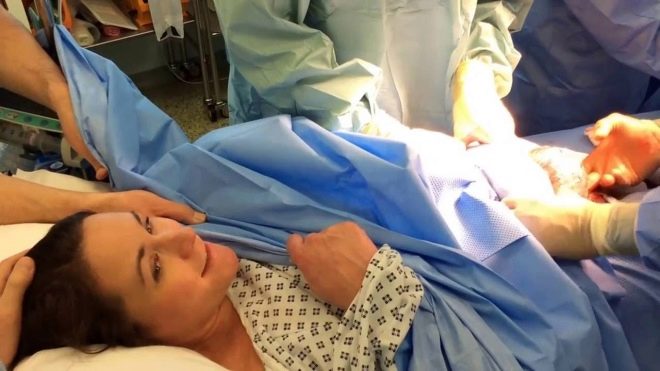Is it dangerous to entangle the umbilical cord around the neck of the fetus and how does it affect childbirth?
During pregnancy, the baby is connected with his mother by a special bond. At the biological level, such a connection is made through the umbilical cord. This article describes in detail whether the cord is entangled around the neck of the fetus, as it affects delivery.
What it is?
The umbilical cord is a very important organ that is formed in the body only in a pregnant woman. In appearance, the umbilical cord resembles a twisted gray-blue cord. The length of the umbilical cord is different. In some cases, it can be quite long, which can contribute to the formation of various pathologies during pregnancy.
One of these pathological conditions is the entanglement of the umbilical cord around the neck of the fetus. In this case, the umbilical loop is located directly on the neck of the child.
Umbilical cord entanglement is a diagnosis that can scare every pregnant woman. Many women remember: when the doctors established such a diagnosis during pregnancy, they experienced a real fright for the life of their baby. You can understand this reaction.
The entanglement of the umbilical cord around the neck of the fetus is a rather dangerous pathology, which requires careful medical observation, as well as the search for the appropriate tactics for the management of pregnancy, and later - the correct method of birth.
Causes
The development of entanglement by the umbilical cord of the fetal neck occurs for various reasons. Doctors identify several reasons that can lead to the development of this pathology during pregnancy:
- Genetics. Looping the umbilical cord of a child’s neck may be due to genetic factors. Some scientists believe that the length of the umbilical cord is a hereditary factor. The average length of the umbilical cord is approximately 40-60 cm. In some cases, its elongation occurs (up to 75-80 cm or more). In such a situation, the risk of entanglement is quite high.
- Stress and traumatic effects. Scientists have revealed an interesting fact: in pregnant women who are often nervous and experiencing on various occasions during pregnancy, a rather high risk of developing this pathology. They believe that the cause is an increase in stress levels of certain hormones, one of which is adrenaline.
Changes in the amount of hormones in the blood can enhance fetal motor activity, as well as lead to certain functional disorders. In some cases this contributes to the entanglement of the umbilical cord around the baby’s neck.
- Change in the amount of amniotic fluid. For the existence and full intrauterine development of the child requires a water environment. If the amniotic fluid is sufficient, the baby feels good. At the same time, his motor activity does not interfere. If, for any reason, the amniotic fluid in the uterus becomes larger, it may contribute to the formation of a number of pathologies. One of them is looping the umbilical cord around the baby’s neck.
- Environmental factors. Some scientists believe that climatic conditions can also cause the baby to wrap around the umbilical cord of the baby’s fetal development. The researchers note that abrupt climate change may lead to the formation of this pathology during pregnancy.Climate change during pregnancy most often contributes to the development of this pathology in women who suffer from any chronic diseases. During pregnancy, moving to another city, where climatic conditions differ significantly, the body of the expectant mother perceives as severe stress. In such a situation, the risk of fetal umbilical cord entanglement increases significantly.
It is believed that overheating and overcooling of the body of a pregnant woman are factors that can contribute to this.
- Smoking. Some doctors note that in women who smoke, entanglement with the umbilical cord is more common. This can be facilitated by the entry into the bloodstream of nicotine and other chemicals that are found in large quantities in cigarettes. They have an adverse effect on the prenatal development of the baby, contribute to the emergence of various diseases.
- Alcohol. The use of alcoholic beverages is another harmful habit that can lead to entanglement by the umbilical cord. Ethanol contained in them has a negative effect on the blood vessels that are in the umbilical cord. Such an impact leads to the occurrence of various disorders in the fetus, including it is a possible factor in the development of the entanglement of the umbilical cord of the baby’s neck.
- Intensive exercise. Obstetricians and gynecologists note that active physical exercise can also lead to entanglement. Expectant mothers who have a long umbilical cord and some other features identified during pregnancy should be extremely careful while playing sports. The possibility of visiting the gym or swimming pool in this situation should be discussed with your doctor. In some cases, entanglement with the umbilical cord of the baby’s neck can be a contraindication for sports and fitness.
Doctors recommend that expectant mothers who have found entanglement spend more time outdoors. At the same time it is better to walk at a moderate pace. Special breathing exercises can also help improve overall health. You can perform them throughout the entire period of pregnancy.
What could be?
The umbilical loops may be wrapped around the neck of the fetus in different ways. Doctors distinguish several clinical variants of this pathology. It all depends on how many times the umbilical loop loops around the neck of the child. Doctors distinguish one-, two-, and three-time entanglement.
If for some reason the umbilical cord is wrapped with its loops more than three times, then such entanglement can be considered multiple. Each of the clinical options has its own specific features of development.
Single
In this version of the pathology, the umbilical cord loop is wrapped around the child’s neck only once. This variant of the pathology occurs in 20-25% of pregnant women. Usually, expectant mothers face zero entanglement. This means that the cord loop tightly surrounds the neck of the fetus and does not squeeze it. The prognosis of the further development of pregnancy with this type of pathology is most favorable.
A tight single entanglement is considered less favorable. In this case, the umbilical cord loop located around the neck can lead to compression of the cervical spine. In such a situation, the child may have very dangerous complications.
Double
In this variant of the pathology, the umbilical loop loops around the fetal neck 2 times. Doctors can determine this pathology at different stages of pregnancy. With early detection, the prognosis is usually quite favorable. If there is a sufficient amount of amniotic fluid in the uterus, and the fetal physical activity is not disturbed, it can still be "unraveled" before the onset of labor.
If, on the other hand, doctors determine that the umbilical cord is twisted around the neck of the fetus after 37-38 weeks of gestation, it will usually remain until the birth. By this time, the baby is already quite large and moves much less. This is due to the fact that with each passing day, the child becomes more “cramped” in the uterus with each passing day.
Triple
This option is found in obstetric practice relatively rarely. Threefold cord entanglement can also lead to the development of a number of complications (or it can proceed relatively normally).
A favorable prognosis in the development of this pathology may be in the event that the umbilical loops do not pinch each other very much. If they squeeze each other tightly, then in such a situation, the child may develop intrauterine hypoxia. In this case, urgent intervention by doctors and the choice of the correct tactics for further pregnancy management are required.
How to suspect?
Direct clinical signs that would indicate the presence of this pathology during pregnancy, unfortunately, are absent. It is possible to suspect the presence of entanglement by the umbilical loops of the fetal neck only if certain complications of the pregnancy have already begun to appear. In most cases, this pathology is detected by chance - during a routine ultrasound.
If the future mother is diagnosed with umbilical cord entanglement around the neck of the fetus, then she should be attentive enough to her general condition, as well as to her baby’s well-being. One of the signs that may indicate that the baby is experiencing discomfort in the womb is a change in its physical activity. Especially well manifested in the fetus after 28-31 weeks of pregnancy. By this time, the baby has a circadian (daily) rhythm. This contributes to the fact that the child is usually more active in the daytime, and usually rests at night.
If the expectant mother began to notice that her baby began to move much less or “activates” too much at night, in that case she should definitely see her obstetrician-gynecologist.
The doctor will conduct the necessary examination, thanks to which it will be clear how the baby feels, if any complications of the pregnancy have developed.
Diagnostics
The basic diagnostic method that can detect this pathology is ultrasound. Before the advent of ultrasound techniques, doctors could not determine the entanglement. This often contributed to the fact that a pregnant woman with this pathology had certain complications during natural childbirth. Currently, ultrasound specialists are quite successful in detecting signs of looping around the umbilical cord of the fetal neck.
Ultrasound examination is a basic, but not the only study that is conducted when establishing the diagnosis of entanglement. To assess the condition of the fetus, doctors must also resort to other diagnostic tests. One of them is a doppler study.
By conducting it, you can assess the blood flow through the vessels that are in the umbilical cord. This allows doctors to eliminate the dangerous complications of the course of pregnancy, including the identification of intrauterine hypoxia. Doctors can dopplerography several times to assess the dynamics of the well-being of a baby in the womb. This allows them to track any possible pathologies and complications that may arise before delivery.
Another diagnostic method that allows to assess the general condition of the fetus is cardiotocography. This simple and painless method allows doctors to determine the work of the child's heart, as well as its physical activity. If everything is normal, no significant changes in these indicators occur.If the baby develops intrauterine hypoxia, this can be indirectly determined on the cardiotogram.
The undoubted advantage of this method is the possibility of its multiple holding. The expectant mother, who had a cord umbilical entanglement, can be prescribed cardiotocography several times before the onset of labor. This dynamic observation allows physicians to identify dangerous complications in a timely manner and, if necessary, change the tactics of pregnancy.
Consequences for the fetus
In order to understand what the danger of the development of various complications in this pathology lies in, it is necessary to touch on a few biological features. It is important to remember that during intrauterine life, the fetus receives oxygen not through the trachea and its own respiratory tract, but in the dissolved form through the blood. Oxygen in this situation enters the child's body through the system of blood arteries that are located in the umbilical cord.
So it becomes clear that the main condition for the normal prenatal development of the baby and the full supply of oxygen to it is the location of the loops around the neck during double and multiple entanglements.
If the loops are tightly clamped, this can lead to a strong squeezing of the blood vessels in the umbilical cord. In such a situation, the fetus does not receive enough dissolved oxygen, which may contribute to the development of intrauterine hypoxia - oxygen deficiency of all internal organs and tissues.
Prolonged intrauterine hypoxia is an extremely dangerous condition. It contributes to the fact that the child disrupts the functioning of all internal organs, including the vital ones - the heart and brain. In such a situation, certain pathologies (and even developmental abnormalities) may develop in the fetus.
Intrauterine hypoxia can lead to an early onset of labor. In this situation, the baby can be born much earlier. In this case, the child may be premature, and his lungs will not be ready for independent breathing.
Strong compression of the blood vessels that are inside the umbilical cord, can lead to disruption of the blood supply to the placenta. In such a situation, the functioning of the placenta is impaired. In some cases, this may even lead to the development of placental abruption in the uterine wall. This pathology can be extremely dangerous and cause the development of preterm labor.
Natural independent labor, complicated by the presence of tight multiple entanglement of the umbilical cord of the fetal neck, can be dangerous and the occurrence of dangerous injuries and injuries. As a rule, the child in this case, there are various injuries of the cervical spine. The severity of such damage is different. To prevent this, doctors still try to resort to performing cesarean section.
It should be remembered that each pregnancy is unique. Doctors can only predict the development of certain complications. The birth of a healthy baby in the presence of an elongated umbilical cord depends on many factors. In one case, a healthy baby is born, and in the other - a child who had some kind of pathology during the birth.
Features of labor
The choice of obstetric tactics largely depends on how tightly the umbilical cord loops around the baby’s neck. With a single entanglement, doctors can resolve natural childbirth. In this case, during labor, the obstetrician-gynecologist always follows the appearance of the head. As soon as she is born, the doctor can remove the umbilical cord loop from the neck. In this case, the natural process of childbirth, as a rule, is not violated.
When detecting a double twisting loops of the umbilical cord of the fetal neck a few weeks before pregnancy, doctors usually choose a surgical method of obstetric aid. In such a situation, natural childbirth can be very dangerous.During labor, umbilical cord loops can strongly squeeze the baby’s neck, leading to the development of dangerous complications (and even, perhaps, to birth trauma).
When the umbilical cord of the fetal neck is twisted three times, doctors often resort to performing a cesarean section. The surgical method of delivery is also used in cases where there are other features of the course of pregnancy.
For information on how to correct the entanglement with the umbilical cord around the neck of the fetus, see the following video.
